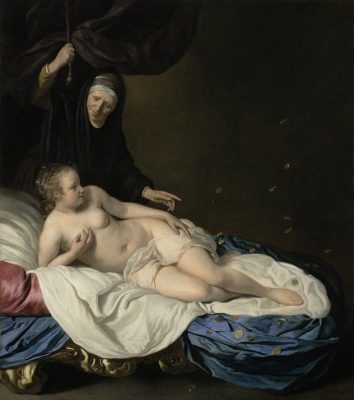In the past few years, the Old Masters collection of the Szépművészeti Múzeum (Museum of Fine Arts) in Budapest has been successfully enriched with three rather significant Dutch works of different styles and subjects. In this news item, CODART member Júlia Tátrai, Head of the Department of Old Master Paintings and Curator of Dutch and Flemish Paintings, introduces these three paintings by Jacob van Loo, Gerard van Honthorst and Ferdinand Bol.
Jacob van Loo
Jacob van Loo (1614-1670) was regarded by his contemporaries as the Amsterdam rival of Rembrandt and Bartholomeus van der Helst. The artist gained acclaim due to his portraits (e.g. the double portrait of Jan Hinlopen and Leonora Huydecoper, Szépművészeti Múzeum) and his paintings of mythological subjects. As for the latter, he usually chose themes that enabled him to depict the naked human body. We find examples of representations of Zeus uniting with Danae in the form of a golden rain back in sixteenth-century Flemish art (Jan Gossaert, Frans Floris, Abraham de Bruyn, Joachim Wtewael), but the subject became particularly popular from the early 1600s. The most well-known example is certainly Hendrick Goltzius’s large size canvas executed in 1603. The fact that a year later Karel van Mander included it in his The Book of Painters (Het Schilder-boeck), published in Dutch, increased the subject’s popularity. Apart from his work in Budapest, Jacob van Loo immortalized the story of Zeus and the princess locked in the brazen tower at least in one further painting. While the piece in the Kremer Collection shows Danae being awakened by her servant, lit by the penetrating ray of light, in the Budapest painting the chief god arrives in the form of golden coins. Danae’s elderly servant calls the young beauty’s attention to the unusual visitor by pulling the curtain from beside the bed. Jacob van Loo must have been familiar with Rembrandt’s painting of the same subject (today in the State Hermitage Museum), which was kept in the master’s house in Amsterdam for a long time. Although the posture of the protagonist and the composition based on an emphatic contrast of light and shade show similarities, Jacob van Loo presents a unique adaptation of the ancient story by his use of cool color tones and Danae’s sculptural and at the same time sensual figure.
Gerard van Honthorst
The other new acquisition in our collection is Gerard van Honthorst’s (1592-1656) dramatic Penitent Magdalene. Its purchase has a special significance for us due to the fact that our otherwise rich Dutch collection held few artworks of Utrecht Caravaggism. Van Honthorst, called Gherardo delle Notti in Italy, did not rely on Caravaggio’s works of similar subjects in this picture. Neither the one showing Magdalene in a contemporary dress, sleeping with her hands resting on her lap (Galleria Doria Pamphilj, Rome), nor the other in which she appears in ecstasy with her head leaned back and her hands clenched (in private collection, Rome). The painting acquired by the Szépművészeti Múzeum places Magdalene between a sharply lit, neutral background and the ivy-covered timbers of the foreground. Although her dress leaves her left breast bare, the figure staring at the cross with a frown, watery eyes and an open mouth does not make the sight of an attractive young woman. With a remarkable portrayal of the soul, Van Honthorst conveys the struggle of horror and doubt within the Penitent Magdalene yet without a faint ray of hope. The painting was executed around 1625; thus, after Van Honthorst’s return from Rome (1620), but before his leave for England (1628). An autograph replica is in possession of the State Hermitage Museum.
Ferdinand Bol
Our Old Masters collection has not held any works of Ferdinand Bol (1616-1680), one of the most significant pupils of Rembrandt, either. The Dordrecht painter was trained in his master’s Amsterdam workshop between 1635 and 1642. Having formed his own, elegant style, he became an artist in demand and achieved great success in his native country. He received commissions for history paintings from, amongst others, the Amsterdam City Hall and the admiralty. Moreover, he made portraits of the most significant personalities of the era, for instance, that of Admiral Engel de Ruyter (Mauritshuis, The Hague), or those of the members of the Trip – De Geer family, who earned their fortune through gun trade. The three-quarter length likeness, often depicted before a landscape and a pulled curtain, was a portrait type that was fashionable amongst the influential Dutch citizenry, and of which Bol’s Budapest picture is a nice example. The work signed and dated 1667 shows the model in a narrow cropping and in close-up, depicting him in a proud, but effortlessly elegant posture. The artist portrayed the iron and copper merchant Pieter Bouwens (1658, in private collection) in a similar composition, before a drawn aside, thick, red curtain. Bol painted the three-quarter length, sitting portrait of David de Wildt, the secretary of the admiralty (Amsterdam Museum, Amsterdam) in the same year that he executed the Budapest painting, and the background is opened on the right by a drawn aside red curtain here, as well. An iconic piece of this portrait type is also connected to Bol’s name: still in 1667, he painted the imposing, life size portrait of Admiral Michiel de Ruyter (Rijksmuseum, Amsterdam).
Jacob van Loo’s Danae, Van Honthorst’s Penitent Mary Magdalene, and Bol’s Portrait of a Man will be on view at the seventeenth century permanent display of the Old Masters Collection of the Szépművészeti Múzeum, opening in December 2021.
– Júlia Tátrai, Head of Department of Old Master Paintings and Curator of Dutch and Flemish Paintings, Szépművészeti Múzeum, Budapest.

[text via codart.nl]